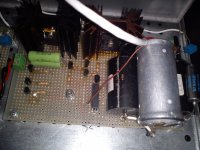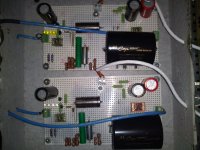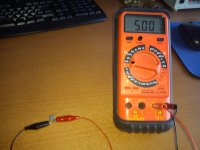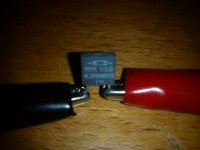The cheap & less esoteric way is Isokinetic but I read the Uwe African Wood body or similar have 8gr of mass so will do perfectly the job.
Hi Merlin
How is your phono pre sounding now ?
If you do not mind, I would like to have your input regarding a new (small) mod I have been experimenting with.
After Mr. Guy´s input, I revised my riaa simulator and came up with new values that really work in my setup.
Would you please post your actual values on the Riaa Filter ?
I need the values you are using for: R1; R3; R4; R5; C2; C3
Please post also the type of components used (SM, Teflon, thin film, carbo... etc)
Best regards
How is your phono pre sounding now ?
If you do not mind, I would like to have your input regarding a new (small) mod I have been experimenting with.
After Mr. Guy´s input, I revised my riaa simulator and came up with new values that really work in my setup.
Would you please post your actual values on the Riaa Filter ?
I need the values you are using for: R1; R3; R4; R5; C2; C3
Please post also the type of components used (SM, Teflon, thin film, carbo... etc)
Best regards
Hi RCruz,
I suppose that you are referenig to the clone Puresound P10?
The Piccolo MC head amp pre-pre is 26dB + 40dB Puresound P10 are a total of 66 dBs, a lot of dBs for my Denon DL103R so I have a little hum in both channels: more in right channel than the left channel but I think it's due to the fact that I'm using a bad Tx: today my friend paid the new Tx Special laminated Bartolucci 200V 100VA so now Giuseppe is in the manufacturing process & more or less between 3 or 4 weeks I will get at home the new Tx.
About the sound it's difficult with this kind of hum, in the headphones sound good still needs open the highs & lows but mids are OK, I compared the Puresound vs Salas Simplistic with Wilson Audio CUB model & there is a lot of difference so the clear winner is the Simplistic, Puresound still needs some tweaks:
PSU
PSU with Nippon chemicon KMH 220uF 450V have to be upgraded with BG or MKP oil filled, also add snubber for rectifiers UF4007 = 47nF+100R before the rectifiers
Salas HV reg
Parallel both film caps with 0.1uF FT3 Russian teflon & 0.015 FT1 Russian teflon, Bourns trimmer for Vref must be changed for Vishay 1280G trimmer the other fixed Vref resistor changed for Mills, resistor to set the current also must be changed for Mills
Tubes
Nothing fancy 6N4 J (Chinese ECC83) + EH6922 (Electro Harmonix), so here can play with some tube that I have on hand RSD ECC83 & ECC88 Russiam military grade NOS.
About the RIAA nothing is changed waiting the new Bartolucci transformer to fix the hum.
Thanks for your interest.
Felipe
I suppose that you are referenig to the clone Puresound P10?
The Piccolo MC head amp pre-pre is 26dB + 40dB Puresound P10 are a total of 66 dBs, a lot of dBs for my Denon DL103R so I have a little hum in both channels: more in right channel than the left channel but I think it's due to the fact that I'm using a bad Tx: today my friend paid the new Tx Special laminated Bartolucci 200V 100VA so now Giuseppe is in the manufacturing process & more or less between 3 or 4 weeks I will get at home the new Tx.
About the sound it's difficult with this kind of hum, in the headphones sound good still needs open the highs & lows but mids are OK, I compared the Puresound vs Salas Simplistic with Wilson Audio CUB model & there is a lot of difference so the clear winner is the Simplistic, Puresound still needs some tweaks:
PSU
PSU with Nippon chemicon KMH 220uF 450V have to be upgraded with BG or MKP oil filled, also add snubber for rectifiers UF4007 = 47nF+100R before the rectifiers
Salas HV reg
Parallel both film caps with 0.1uF FT3 Russian teflon & 0.015 FT1 Russian teflon, Bourns trimmer for Vref must be changed for Vishay 1280G trimmer the other fixed Vref resistor changed for Mills, resistor to set the current also must be changed for Mills
Tubes
Nothing fancy 6N4 J (Chinese ECC83) + EH6922 (Electro Harmonix), so here can play with some tube that I have on hand RSD ECC83 & ECC88 Russiam military grade NOS.
About the RIAA nothing is changed waiting the new Bartolucci transformer to fix the hum.
Thanks for your interest.
Felipe
I added some mass to the headshell of the RB300 I am using with my DL103 and it works wonderfully.
I agree with you that the DL103 needs some mass to show it´s true character.
My friend Luis Pires (the man behind the Benz LP) kept telling me the benefits of using a high mass body for the MC carts. He personally chose the special African Wood used in the LP.
Maybe it would be a good idea to build a good wood body for the DL103..... 🙂
Let me know your subjective opinion about increasing mass for Denon DL103R?
Hi Ricardo
About SE Simplistic, I changed the fixed Vishay Vref for a trimmer Vishay 1280G & the sounds has changed to better with more harmonics that's the reason I increased capacitance in C3 it's OK?
R1 3K3 Kiwame 2W carbon
R3 45K804 Vishay TX2575// 3M standard metal film
R4 6K8 Vishay nude Tx2575 + 1Meg Caddock TF020
R5 1Meg Caddock MK132
C2 47nF teflon + SM
C3 15.89nF teflon + SM
Thank you for help
Felipe
About SE Simplistic, I changed the fixed Vishay Vref for a trimmer Vishay 1280G & the sounds has changed to better with more harmonics that's the reason I increased capacitance in C3 it's OK?
R1 3K3 Kiwame 2W carbon
R3 45K804 Vishay TX2575// 3M standard metal film
R4 6K8 Vishay nude Tx2575 + 1Meg Caddock TF020
R5 1Meg Caddock MK132
C2 47nF teflon + SM
C3 15.89nF teflon + SM
Thank you for help
Felipe
Attachments
What is the value of the SM you are using in C2 47nF teflon + SM ?
IMO C3 is ok (you can tune it acording to your needs)
IMO C3 is ok (you can tune it acording to your needs)
Acording to my most recent findings, I suggest you add alittle more SM there untill you reach 47.08nF (You need more 80p).
My next suggestion is what I really would like you to do so I could get your oppinion.
I found that in your case I would replace the 3M in parallel with the R3 45K804 Vishay by a 5M.
I did this in my phonos and the sound gained a lot in attack and trebble delineation. trebble is stronger also.
As it might be very difficult to get a 5M resistor, let me know if you can do it .
My next suggestion is what I really would like you to do so I could get your oppinion.
I found that in your case I would replace the 3M in parallel with the R3 45K804 Vishay by a 5M.
I did this in my phonos and the sound gained a lot in attack and trebble delineation. trebble is stronger also.
As it might be very difficult to get a 5M resistor, let me know if you can do it .
Fortunately I have a couple of resistors Caddock MK132 4.99Meg have I to add 10K or nearest value to DVM reads 5M? about caps the nearest value I can reach with two paralleled caps 68pf //15pF are 83,3pF & 82,4pF can be good?
Attachments
Those are perfect values for the caps.
You do not need the extra 10k.... The 4M99 is ok.
Thank you so much for your help. After you do the mods, you must wait at least 24 hours before you can evaluate the sound correctly.... It might sound a little harsh in the begining.
If you need more highs, you can always reduce the 15n cap.
You do not need the extra 10k.... The 4M99 is ok.
Thank you so much for your help. After you do the mods, you must wait at least 24 hours before you can evaluate the sound correctly.... It might sound a little harsh in the begining.
If you need more highs, you can always reduce the 15n cap.
Hi Merlin
Once you told me you had R4 = 6810r // 1M
Now you informed R4 = 6800r // 1M
What is the correct value 6800 or 6810r ?
Once you told me you had R4 = 6810r // 1M
Now you informed R4 = 6800r // 1M
What is the correct value 6800 or 6810r ?
In that case, just add 10pF to your 47nF cap instead of 83pF 🙂
This added value will slightly increase attack and detail.
This added value will slightly increase attack and detail.
Last edited:
And how you know for those capacitors and resistors that you so exactly calculate, if you don't have some $2000 0.1% desktop LCR meter with Kelvin leads, ambient temp auto re-calibration etc.? I bet you are +/-0.25nF off with any 1% stated 2 leads $100 LCR. Usually -%.
That is right... I can not know the exact values but I was hoping Merlin´s DMM would error in the same side for the resistor and capacitances values... That way we should be able to maintain the correct relation between parts values.
Anyway, the general idea is that a higher value in the 47n cap will improve attack, a lower value should smooth things a bit.
His resistors seem to have very acurate values... let´s hope the caps are also spot on.
Anyway, the general idea is that a higher value in the 47n cap will improve attack, a lower value should smooth things a bit.
His resistors seem to have very acurate values... let´s hope the caps are also spot on.
Last edited:
And how you know for those capacitors and resistors that you so exactly calculate, if you don't have some $2000 0.1% desktop LCR meter with Kelvin leads, ambient temp auto re-calibration etc.? I bet you are +/-0.25nF off with any 1% stated 2 leads $100 LCR. Usually -%.
Wavetek Meterman LCR55 isn't cheap LCR meter
Resistance is adjusted to zero at the 20R switch position with the 20R/Adjust so can be calibrated each time to be sure good calibration.
-Resolution, 20Ω range: 10mΩ.
-Accuracy, 200Ω range: ±1.2% rdg (zero adjust)
200Ω range: ±0.5% rdg +3dgt
2k to 2MΩ rgs: ±(0.5% rdg +1dgt)
20MΩ rg: ±(2.0% rdg +2dgt
The LCR55 has a residual capacitance of approximately 6pF in the 200nF
range. When using the 200nF range, note the residual capacitance and subtract this value from the measured value. Small value capacitors can also be measured by inserting their leads directly into the Cx/Lx slots in the meter to avoid self capacitance cables & probes.
-Accuracy*, 200pF to 200nF: ±(1.0% rdg +1dgt) *Note: in lower ranges, substract 6 points residual offset reading from result.
-Test Frequency, 200p to 2μF: 1000Hz; 20, 200μF ranges: 100Hz; 2000μF range: 10Hz.
-Temperature Coefficient, ≤0.5μF: 0.1%/°C; >0.5μF: 0.2%/°C. Temperature coefficient: 0.1 x (spec. accur.) per °C (0-18°C, 28-50°C)
http://assets.metermantesttools.com/manuals/LCR55_Manual.PDF
And how you know for those capacitors and resistors that you so exactly calculate, if you don't have some $2000 0.1% desktop LCR meter with Kelvin leads, ambient temp auto re-calibration etc.? I bet you are +/-0.25nF off with any 1% stated 2 leads $100 LCR. Usually -%.
This can be OK?
AIM-TTI INSTRUMENTS|LCR400|PUENTE LCR | Farnell España
- Home
- Source & Line
- Analogue Source
- Simplistic NJFET RIAA



